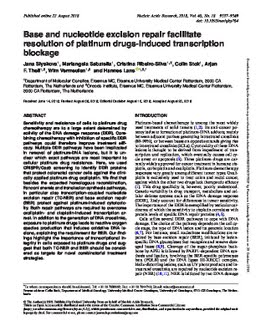2018-10-12
Base and nucleotide excision repair facilitate resolution of platinum drugs-induced transcription blockage
Publication
Publication
Nucleic Acids Research , Volume 46 - Issue 18 p. 9537- 9549
Sensitivity and resistance of cells to platinum drug chemotherapy are to a large extent determined by activity of the DNA damage response (DDR). Combining chemotherapy with inhibition of specific DDR pathways could therefore improve treatment efficacy. Multiple DDR pathways have been implicated in removal of platinum-DNA lesions, but it is unclear which exact pathways are most important to cellular platinum drug resistance. Here, we used CRISPR/Cas9 screening to identify DDR proteins that protect colorectal cancer cells against the clinically applied platinum drug oxaliplatin. We find that besides the expected homologous recombination, Fanconi anemia and translesion synthesis pathways, in particular also transcription-coupled nucleotide excision repair (TC-NER) and base excision repair (BER) protect against platinum-induced cytotoxicity. Both repair pathways are required to overcome oxaliplatin- and cisplatin-induced transcription arrest. In addition to the generation of DNA crosslinks, exposure to platinum drugs leads to reactive oxygen species production that induces oxidative DNA lesions, explaining the requirement for BER. Our findings highlight the importance of transcriptional integrity in cells exposed to platinum drugs and suggest that both TC-NER and BER should be considered as targets for novel combinatorial treatment strategies.
| Additional Metadata | |
|---|---|
| doi.org/10.1093/nar/gky764, hdl.handle.net/1765/111164 | |
| Nucleic Acids Research | |
| Organisation | Erasmus MC: University Medical Center Rotterdam |
|
Slyskova, J. (Jana), Sabatella, M., Ribeiro-Silva, C., Stok, C. (Colin), Theil, A., Vermeulen, W., & Lans, H. (2018). Base and nucleotide excision repair facilitate resolution of platinum drugs-induced transcription blockage. Nucleic Acids Research, 46(18), 9537–9549. doi:10.1093/nar/gky764 |
|

